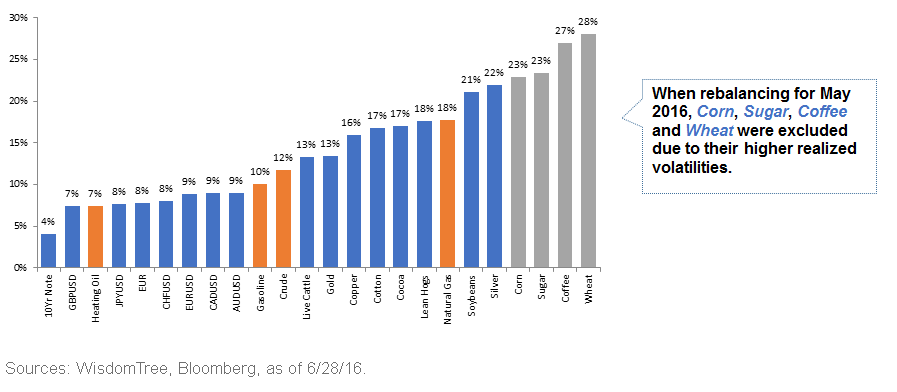The WisdomTree Managed Futures Index: An Introduction


 Further, our research showed that one of the great risks to managed futures strategies is the whipsaw risk, in which a position is established based on recent trends but commodity volatility whipsaws into a different direction. Scaling position size based on the composite momentum framework described above is one element to help reduce that risk, but we have further sought to reduce the risk of being caught on the wrong side of the trend by removing the commodities with the highest volatility over the last 36 months from the universe and allocations.
Our research showed that commodities with the highest volatility were some of the weakest performers for applying a long/short momentum approach.
The chart below reveals the standard deviation, or volatility, over the last 36 months of the various commodities, currencies and interest rates included in the WisdomTree Managed Futures Index. The four highest-volatility commodities are excluded from the Index for the upcoming month. Those commodities currently are corn, sugar, coffee and wheat.
Realized Volatilities of Assets in the Investment Universe (%)
Monthly Data, Last 36 Months under CMS framework as of 06/28/2016
Further, our research showed that one of the great risks to managed futures strategies is the whipsaw risk, in which a position is established based on recent trends but commodity volatility whipsaws into a different direction. Scaling position size based on the composite momentum framework described above is one element to help reduce that risk, but we have further sought to reduce the risk of being caught on the wrong side of the trend by removing the commodities with the highest volatility over the last 36 months from the universe and allocations.
Our research showed that commodities with the highest volatility were some of the weakest performers for applying a long/short momentum approach.
The chart below reveals the standard deviation, or volatility, over the last 36 months of the various commodities, currencies and interest rates included in the WisdomTree Managed Futures Index. The four highest-volatility commodities are excluded from the Index for the upcoming month. Those commodities currently are corn, sugar, coffee and wheat.
Realized Volatilities of Assets in the Investment Universe (%)
Monthly Data, Last 36 Months under CMS framework as of 06/28/2016
 In a future blog post, we will take an in-depth look at how the new WisdomTree Managed Futures Strategy Fund (WDTI) is positioned in the current market environment. Until then, you can view the live WisdomTree Managed Futures Index constituents here.
In a future blog post, we will take an in-depth look at how the new WisdomTree Managed Futures Strategy Fund (WDTI) is positioned in the current market environment. Until then, you can view the live WisdomTree Managed Futures Index constituents here.
Important Risks Related to this Article
There are risks associated with investing, including possible loss of principal. An investment in this Fund is speculative and involves a substantial degree of risk. One of the risks associated with the Fund is the complexity of the different factors that contribute to the Fund’s performance, as well as its correlation (or noncorrelation) to other asset classes. These factors include use of long and short positions in commodity futures contracts, currency forward contracts, swaps and other derivatives. Derivative investments can be volatile, and these investments may be less liquid than other securities and more sensitive to the effects of varied economic conditions.
The Fund generally does not make intramonth adjustments and therefore is subject to substantial losses if the market moves against the Fund’s established positions on an intramonth basis. The Fund is actively managed; thus, the ability of the Fund to achieve its objectives will depend on the effectiveness of the portfolio manager. Due to the investment strategy of this Fund, it may make higher capital gain distributions than other ETFs. Please read the Fund’s prospectus for specific details regarding the Fund’s risk profile.
Diversification does not eliminate the risk of experiencing investment losses. Investments in commodities may be affected by overall market movements, changes in interest rates and other factors such as weather, disease, embargoes and international economic and political developments. Commodities and futures are generally volatile and are not suitable for all investors.

Jeremy Schwartz has served as our Global Chief Investment Officer since November 2021 and leads WisdomTree’s investment strategy team in the construction of WisdomTree’s equity Indexes, quantitative active strategies and multi-asset Model Portfolios. Jeremy joined WisdomTree in May 2005 as a Senior Analyst, adding Deputy Director of Research to his responsibilities in February 2007. He served as Director of Research from October 2008 to October 2018 and as Global Head of Research from November 2018 to November 2021. Before joining WisdomTree, he was a head research assistant for Professor Jeremy Siegel and, in 2022, became his co-author on the sixth edition of the book Stocks for the Long Run. Jeremy is also co-author of the Financial Analysts Journal paper “What Happened to the Original Stocks in the S&P 500?” He received his B.S. in economics from The Wharton School of the University of Pennsylvania and hosts the Wharton Business Radio program Behind the Markets on SiriusXM 132. Jeremy is a member of the CFA Society of Philadelphia.

